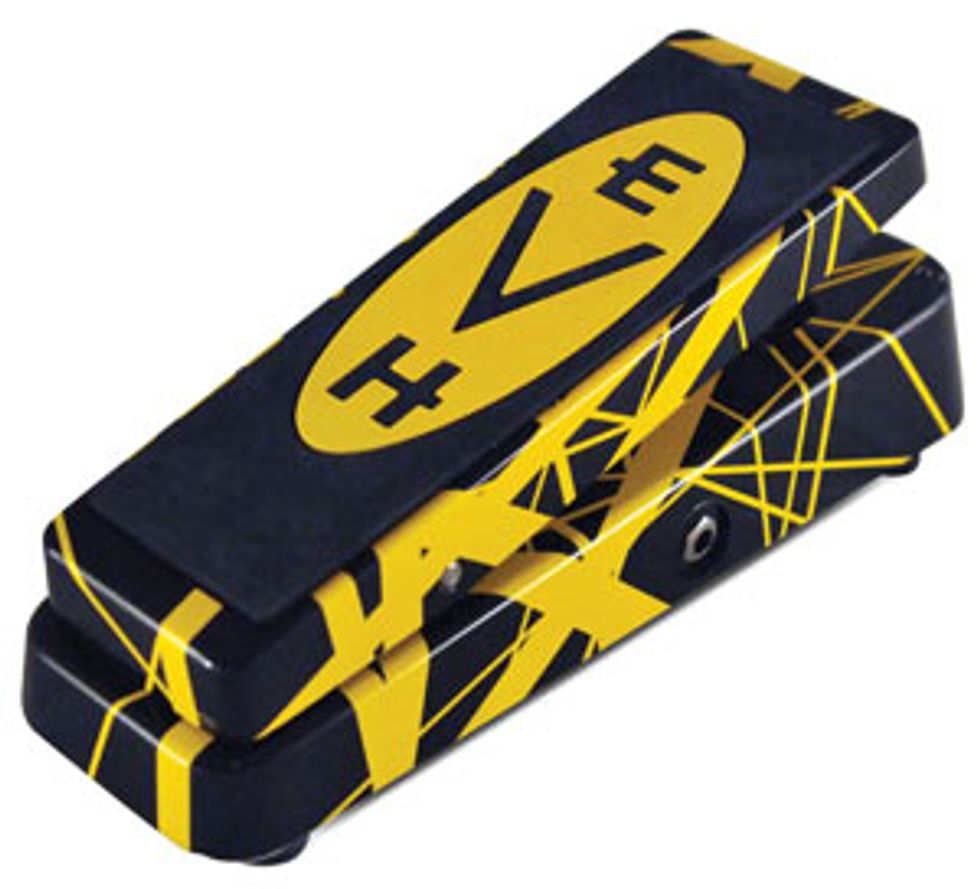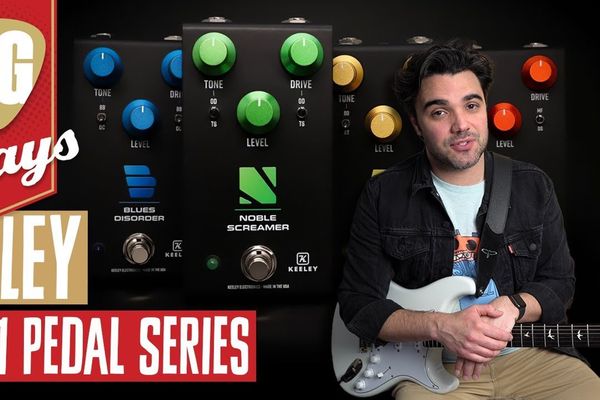A full-featured Wah for EVH fans
 | |
| Download Example 1 | |
| Download Example 2 | |
| Download Example 3 | |
| Recorded using a 1974 Gibson Les Paul Custom on both bridge and neck pickupa through a Carol-Ann OD2r head into a Mojave 2x12 cab with 1963 Celestion Alnico Blues. | |
Cleverly completing the color scheme trifecta, the EVH Wah sports the trademarked EVH stripes in yellow on a black base (the EVH Phase 90 is white-red; the Flanger is whiteblack), just like his famed Frankenstrat on the back cover of Van Halen II. It is housed in the standard Crybaby casing, but with a smooth, flat rubber footpad with “EVH” lettering, rather than the typical corrugated rubber mat. It offers true hardware bypass as well as a pair of bright blue LEDs… a welcome addition, especially for live performance. Finally, the pot is cloned after the worn-in one on EVH’s original pedal, which apparently had a more defined midrange and increased lowend sweep due to the way he used it.
I had the luxury of spending a good deal of time with the EVH wah, and test drove it through a variety of amps and guitars over the course of a week. Running a Charvel Strat into an earlyeighties Legend Rock ‘N’ Roll 50 combo (think Billy Gibbons Eliminator-era ZZ Top tone), it was immediately clear that the sweep frequencies were unique. The EVH’s tone was slightly more focused toward the centered mids, and with the added bonus of an ultra smooth taper. With that smooth taper, it was easy to coax sweet tones out of the wah since just about every position yielded a sound that sat well within the amp and guitar’s natural register—some wahs tend to get rather brash at the top of the travel, and the lowest notes can bottom out and lose gain. While the EVH definitely has the lower register covered and never bottomed out when down, I did find myself pushing the pedal to the floor but never quite reaching that super high-end squawk I’m used to hearing. On a Fender Strat through a Marshall, it was very agreeable with the single coil pickups and felt right at home and never screechy or harsh. And both of my Les Pauls with different pickups (’74 with stock humbuckers, ’03 with Sheptone Tribute PAFs) loved the EVH and were able to churn out thick and chewy expressive tones with ease.
There are some really great features on the EVH that should be noted. First off, the switch is fantastic. Most of the wah’s I’ve used have a stubborn switch that is difficult to engage—and can be tricky in a live setting to tell if it’s been turned on or off. The EVH does double-duty by making the switch a very obvious yet easy click when stomping on the pedal, as well as lighting up two ultra-bright blue LEDs. There is no mistaking when the wah is engaged and that’s a very good thing… definitely the best implementation I’ve seen on a wah to date. The other bonus is the easy travel of the pedal. Somehow it feels like the pedal has a longer travel to it, making it less finicky about finding the sweet spots. With other wahs I find myself micro-managing the pedal and searching for the right frequency, which can take time to get comfortable with. The EVH feels really good on the foot, and “locks in” in such a way that you feel like you have solid control over tone colors. That is definitely a bonus; this pedal doesn’t take any time to get used to.
While the EVH wah isn’t exactly a nod to the past, it’s nice to see a different flavor added to the line of Cry Baby products. Besides that, we already have enough wahs designed to cop the tone of the vintage ones, so new is good in this case. It also represents the taste of a particular guitarist, and if you agree with that you’ll be very happy with this pedal. Even if you aren’t a diehard EVH fan, you might find that the EVH wah serves up just the tone you’re looking for, as it’s clearly a well-built pedal from a tried and true company.
Buy if...
You want a new flavor of wah with great modern conveniences.
Skip if...
You’re looking for a classic tone and don’t want to sport the EVH stripes on your pedal board.
Rating...
Street $169 -Dunlop - jimdunlop.com |
From Your Site Articles
![Knocked Loose Rig Rundown [2024]](https://www.premierguitar.com/media-library/rig-rundown-knocked-loose-2024.jpg?id=52195176&width=600&height=400&quality=85&coordinates=0%2C0%2C200%2C0)
